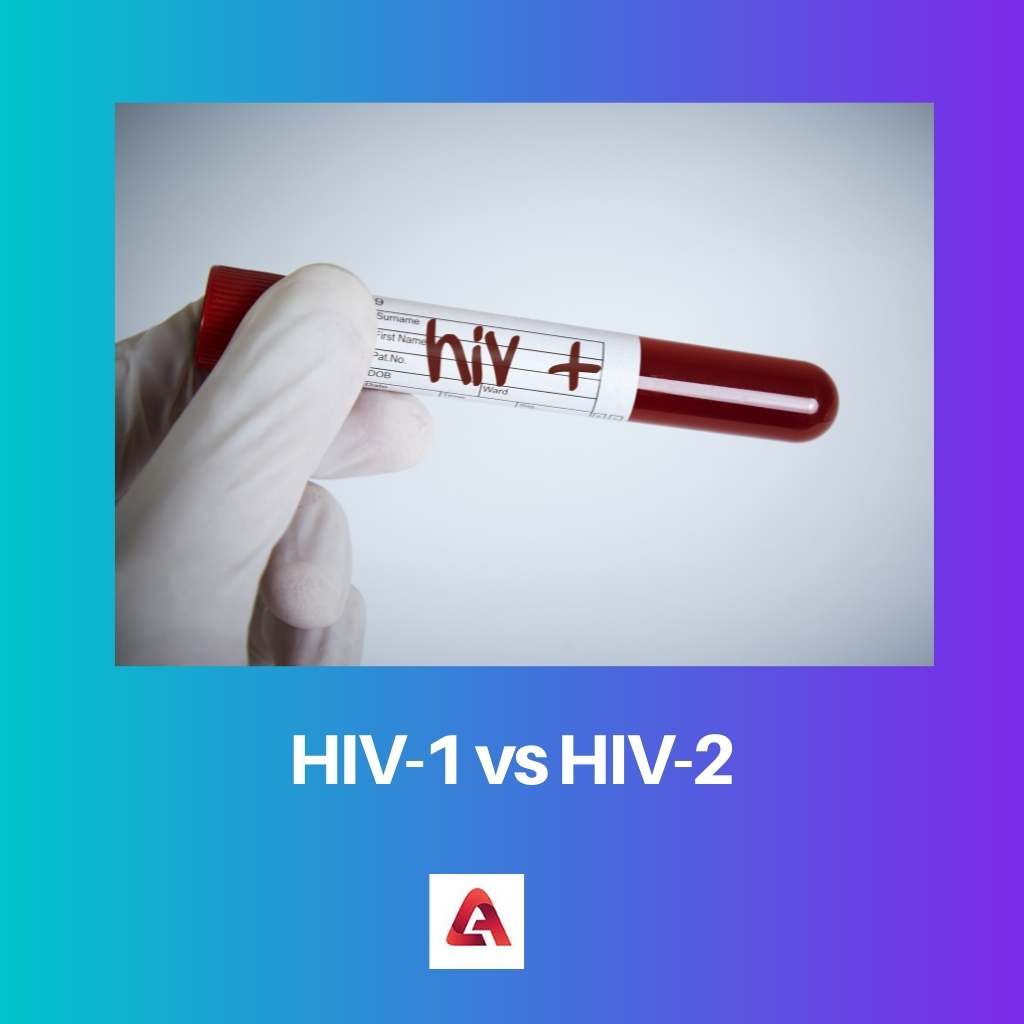HIV is a virus that affects immune system cells. CD4+ cells aid the immune system’s ability to fight infections. The body becomes less tolerant to infections and disorders when the number of these cells is diminished.
HIV is mostly spread through the infected person’s body fluids. Acute immunodeficiency syndrome can develop if HIV is not treated.
Consequently, antiretroviral therapy is required to lower viral load and protect Spread of HIV to the patient’s sexual partners.
Key Takeaways
- HIV-1 and HIV-2 are two different strains of the Human Immunodeficiency Virus (HIV).
- HIV-1 is more prevalent and virulent than HIV-2 and is found worldwide, while HIV-2 is primarily found in West Africa.
- HIV-1 has a faster progression to AIDS and is more difficult to treat than HIV-2.
HIV-1 vs HIV-2
HIV-1 is the most common type of HIV globally and is responsible for the majority of HIV infections. HIV-2 is mainly found in West Africa, accounting for a smaller proportion of HIV infections worldwide, and is less transmissible, less virulent and progresses more slowly than HIV-1.

HIV-1 is a retrovirus that evolved from a similar virus seen in chimps. It’s thought that humans contracted the virus after coming into touch with the fluids of chimps they had slain.
The window period for each diagnostic method is different. This really is the time from when a person is infected with a virus and when the test can identify it effectively.
During analysis, a healthcare practitioner will consider the test’s window period. It’s likely that a second test will be required after the window time has gone to confirm a negative result.
HIV-2 infection was once thought to be more benign than HIV-1 infection, and many people can live a normal life even without antiretroviral therapy.
However, the researchers discovered that both kinds of HIV infection had a significant risk of dying from AIDS absent ART after reviewing over 20 years of obey data from persons with HIV-1 and HIV-2.
AIDS occurred at higher CD4 cell levels in patients with HIV-2 infection than in people with HIV-1 infection, despite HIV-2 being linked with a shorter illness course.
Comparison Table
| Parameters of Comparison | HIV-1 | HIV-2 |
|---|---|---|
| Origin | HIV-1 is originated from the common chimpanzee. | HIV-2 is originated from sooty mangabey. |
| Infective | HIV-1 is highly infective. | HIV-2 is less infective. |
| Virulence | HIV-1 is highly virulent. | HIV-2 is less virulent. |
| Heterosexuals’ Spread | HIV-1 has a high chance of spreading. | HIV-2 has fewer chances of spread. |
| Genetic Diversity | There is no genetic diversity. | There is low genetic diversity. |
What is HIV-1?
The Human Immunodeficiency Virus (HIV-1) is the most frequent kind. It targets the immune response of your body. CD4 cells are destroyed by the virus.
These cells aid in the fight against disease in your body. HIV-1 can cause significant body immune damage, leading to Acute Immune Deficiency Syndrome. Treatments for HIV-1 may lower the level of HIV-1 in your blood.
Treatments may also aid in the increase of CD4 cells in your bloodstream. These cells aid in the fight against various infections. When an HIV-1 medicine is used in conjunction with other HIV-1 drugs, it is more likely to be successful.
Antiretroviral therapy is a mixture of drugs used to treat the human immunodeficiency virus. Although antiretroviral therapy cannot cure HIV, it can help people live longer.
ART prevents the virus from multiplying and decreases the number of viruses in the body, allowing the patient to live healthier lives.
In order for the drug to be effective, the patient must comply with the prescribed dosage once treatment is started. Non-compliance can lead to the development of resistance.
Although mortality has improved since the implementation of cART, the disease still an important disease impact. Test losses and difficulties in developing a remedy have been especially discouraging.
What is HIV-2?
What is HIV-2? However, in the population of people who do not receive the therapy, they will develop AIDS and die.
There have been no randomized control trials to determine when a person with HIV-2 should begin antiretroviral therapy or which regimes are most successful for first-line or second-line ART for managing HIV-2, so the best medical strategy remains unknown.
ART should be begun at or shortly after HIV-2 diagnosis to limit the progression of the disease and HIV-2 transmissions to others, according to available data on the therapy of HIV-2, and extrapolate from data on the therapy of HIV-1.
The accurate plasma HIV-2 RNA viral testing process for clinical treatment is now accessible and should be done prior to starting antiretroviral therapy.
Even if their viral loads are stably suppressed, HIV-2 patients should have their CD4 counts checked on a regular basis since the progression of the disease can occur even with a negative viral load.
HIV-2 patients may experience viral changes related to drug resistance when receiving ART treatment. However, no antibiotic tolerance assays for HIV-2 genotypic or phenotypic resistance have been authorized for clinical use.
In the case of viral load, immunological, or therapeutic failure, a new antiretroviral therapy protocol should be devised in cooperation with an HIV-2 expert.
Main Differences Between HIV-1 and HIV-2
- HIV-1 is a virus that originates in chimps. Sooty mangabey is the source of HIV-2.
- HIV-1 is extremely contagious, whereas HIV-2 is less infectious than HIV-1.
- HIV-1 has a high level of pathogenicity, whereas HIV-2 has lower pathogenicity than HIV-1.
- HIV-1 has a high risk of spreading, whereas HIV-2 has a lower risk of spreading.
- HIV-1 has no genetic diversity, whereas HIV-2 has less genetic diversity.




